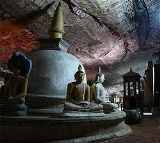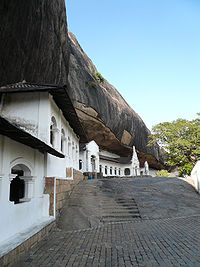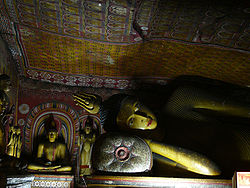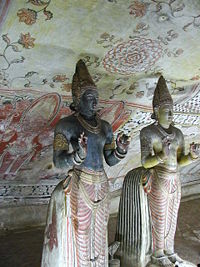
Dambulla cave temple
Encyclopedia
Dambulla cave temple also known as the Golden Temple of Dambulla is a World Heritage Site
(1991) in Sri Lanka
, situated in the central part of the country. This site is situated 148 km east of Colombo
and 72 km north of Kandy
. It is the largest and best-preserved cave temple complex in Sri Lanka. The rock towers 160 m over the surrounding plains.There are more than 80 documented caves in the surrounding area. Major attractions are spread over 5 caves, which contain statues
and paintings. These paintings and statues are related to Lord Buddha
and his life. There are total of 153 Buddha statues, 3 statues of Sri Lankan kings and 4 statues of gods and goddesses. The latter include two statues of Hindu
gods, the god Vishnu
and the god Ganesh. The murals cover an area of 2,100 square meters. Depictions on the walls of the caves include the temptation by the demon Mara
, and Buddha's first sermon
.
Prehistoric Sri Lankans would have lived in these cave complexes before the arrival of Buddhism in Sri Lanka as there are burial sites with human skeletons about 2700 years old in this area, at Ibbankatuwa near the Dambulla cave complexes.
 Dating back to the 1st century BC, this is the most impressive cave temple in Asia. It has five caves under a vast overhanging rock, carved with a drip line to keep the interiors dry. In 1938 the architecture was embellished with arched colonnades and gabled entrances. Inside the caves, the ceilings are painted with intricate patterns of religious images following the contours of the rock. There are images of the Lord Buddha and bodhisattvas, as well as various gods and goddesses.
Dating back to the 1st century BC, this is the most impressive cave temple in Asia. It has five caves under a vast overhanging rock, carved with a drip line to keep the interiors dry. In 1938 the architecture was embellished with arched colonnades and gabled entrances. Inside the caves, the ceilings are painted with intricate patterns of religious images following the contours of the rock. There are images of the Lord Buddha and bodhisattvas, as well as various gods and goddesses.
The Dambulla cave monastery is still functional and remains the best-preserved ancient edifice in Sri Lanka. This complex dates from the 3rd and 2nd centuries BC, when it was already established as one of the largest and most important monasteries. King Valagambahu is traditionally thought to have converted the caves into a temple in the 1st century BC. Exiled from Anuradhapura
, he sought refuge here from South Indian usurpers for 15 years. After reclaiming his capital, the King built a temple in thankful worship. Many other kings added to it later and by the 11th century, the caves had become a major religious centre and still are. King Nissanka Malla gilded the caves and added about 70 Buddha statues in 1190. During the 18th century, the caves were restored and painted by the Kandyan Kings.
 The temple is composed of five caves, which have been converted into shrine rooms. The caves, built at the base of a 150m high rock during the Anuradhapura
The temple is composed of five caves, which have been converted into shrine rooms. The caves, built at the base of a 150m high rock during the Anuradhapura
(1st century BC to 993 AD) and Polonnaruwa
times (1073 to 1250), are by far the most impressive of the many cave temples found in Sri Lanka
. Access is along the gentle slope of the Dambulla
Rock, offering a panoramic view of the surrounding flat lands, which includes the rock fortress Sigiriya
, 19 km away. Dusk brings hundreds of swooping swallows to the cave entrance. The largest cave measures about 52m from east to west, and 23m from the entrance to the back, this spectacular cave is 7m tall at its highest point. Hindu deities are also represented here, as are the kings Valagamba and Nissankamalla, and Ananda
- the Buddha's most devoted disciple.
, said to have used his divine powers to create the caves.
 In the second and largest cave, in addition to 16 standing and 40 seated statues of Buddha, are the gods Saman
In the second and largest cave, in addition to 16 standing and 40 seated statues of Buddha, are the gods Saman
and Vishnu, which pilgrims often decorate with garlands, and finally statues of King Vattagamani Abhaya, who honored the monastery in the 1st century BC., and King Nissanka Malla, responsible in the 12th century for the gilding of 50 statues, as indicated by a stone inscription near the monastery entrance. This cave is accordingly called Maharaja lena, "Cave of the Great Kings." The Buddha statue hewn out of the rock on the left side of the room is escorted by wooden figures of the Bodhisattvas Maitreya and Avalokiteshvara or Natha. There is also a dagoba and a spring which drips its water, said to have healing powers, out of a crack in the ceiling. Valuable tempera paintings on the cave ceiling dating from the 18th century depict scenes from Buddha's life, from the dream of Mahamaya to temptation by the demon Mara. Further pictures relate important events from the country's history.
style during the reign of King Kirti Sri Rajasinha (1747–1782), the famous Buddhist revivalist. In addition to the 50 Buddha statues, there is also a statue of the king.
World Heritage Site
A UNESCO World Heritage Site is a place that is listed by the UNESCO as of special cultural or physical significance...
(1991) in Sri Lanka
Sri Lanka
Sri Lanka, officially the Democratic Socialist Republic of Sri Lanka is a country off the southern coast of the Indian subcontinent. Known until 1972 as Ceylon , Sri Lanka is an island surrounded by the Indian Ocean, the Gulf of Mannar and the Palk Strait, and lies in the vicinity of India and the...
, situated in the central part of the country. This site is situated 148 km east of Colombo
Colombo
Colombo is the largest city of Sri Lanka. It is located on the west coast of the island and adjacent to Sri Jayawardenapura Kotte, the capital of Sri Lanka. Colombo is often referred to as the capital of the country, since Sri Jayawardenapura Kotte is a satellite city of Colombo...
and 72 km north of Kandy
Kandy
Kandy is a city in the center of Sri Lanka. It was the last capital of the ancient kings' era of Sri Lanka. The city lies in the midst of hills in the Kandy plateau, which crosses an area of tropical plantations, mainly tea. Kandy is one of the most scenic cities in Sri Lanka; it is both an...
. It is the largest and best-preserved cave temple complex in Sri Lanka. The rock towers 160 m over the surrounding plains.There are more than 80 documented caves in the surrounding area. Major attractions are spread over 5 caves, which contain statues
Statues
Statues is a popular children's game, often played in Australia but with versions throughout the world.-General rules:# A person starts out as the "Curator" and stands at the end of a field. Everyone else playing stands at the far end...
and paintings. These paintings and statues are related to Lord Buddha
Gautama Buddha
Siddhārtha Gautama was a spiritual teacher from the Indian subcontinent, on whose teachings Buddhism was founded. In most Buddhist traditions, he is regarded as the Supreme Buddha Siddhārtha Gautama (Sanskrit: सिद्धार्थ गौतम; Pali: Siddhattha Gotama) was a spiritual teacher from the Indian...
and his life. There are total of 153 Buddha statues, 3 statues of Sri Lankan kings and 4 statues of gods and goddesses. The latter include two statues of Hindu
Hindu
Hindu refers to an identity associated with the philosophical, religious and cultural systems that are indigenous to the Indian subcontinent. As used in the Constitution of India, the word "Hindu" is also attributed to all persons professing any Indian religion...
gods, the god Vishnu
Vishnu
Vishnu is the Supreme god in the Vaishnavite tradition of Hinduism. Smarta followers of Adi Shankara, among others, venerate Vishnu as one of the five primary forms of God....
and the god Ganesh. The murals cover an area of 2,100 square meters. Depictions on the walls of the caves include the temptation by the demon Mara
Mara (demon)
In Buddhism, Māra is the demon that tempted Gautama Buddha by trying to seduce him with the vision of beautiful women who, in various legends, are often said to be Mara's daughters. In Buddhist cosmology, Mara personifies unwholesome impulses, unskillfulness, the "death" of the spiritual life...
, and Buddha's first sermon
Sermon
A sermon is an oration by a prophet or member of the clergy. Sermons address a Biblical, theological, religious, or moral topic, usually expounding on a type of belief, law or behavior within both past and present contexts...
.
Prehistoric Sri Lankans would have lived in these cave complexes before the arrival of Buddhism in Sri Lanka as there are burial sites with human skeletons about 2700 years old in this area, at Ibbankatuwa near the Dambulla cave complexes.
History

The Dambulla cave monastery is still functional and remains the best-preserved ancient edifice in Sri Lanka. This complex dates from the 3rd and 2nd centuries BC, when it was already established as one of the largest and most important monasteries. King Valagambahu is traditionally thought to have converted the caves into a temple in the 1st century BC. Exiled from Anuradhapura
Anuradhapura
Anuradhapura, , is one of the ancient capitals of Sri Lanka, famous for its well-preserved ruins of ancient Lankan civilization.The city, now a UNESCO World Heritage Site, lies 205 km north of the current capital Colombo in Sri Lanka's North Central Province, on the banks of the historic...
, he sought refuge here from South Indian usurpers for 15 years. After reclaiming his capital, the King built a temple in thankful worship. Many other kings added to it later and by the 11th century, the caves had become a major religious centre and still are. King Nissanka Malla gilded the caves and added about 70 Buddha statues in 1190. During the 18th century, the caves were restored and painted by the Kandyan Kings.
The five caves

Anuradhapura
Anuradhapura, , is one of the ancient capitals of Sri Lanka, famous for its well-preserved ruins of ancient Lankan civilization.The city, now a UNESCO World Heritage Site, lies 205 km north of the current capital Colombo in Sri Lanka's North Central Province, on the banks of the historic...
(1st century BC to 993 AD) and Polonnaruwa
Polonnaruwa
The second most ancient of Sri Lanka's kingdoms, was first declared the capital city by King Vijayabahu I, who defeated the Chola invaders in 1070 AD to reunite the country once more under a local leader.-History:While Vijayabahu's victory and shifting of Kingdoms to the more strategic Polonnaruwa...
times (1073 to 1250), are by far the most impressive of the many cave temples found in Sri Lanka
Sri Lanka
Sri Lanka, officially the Democratic Socialist Republic of Sri Lanka is a country off the southern coast of the Indian subcontinent. Known until 1972 as Ceylon , Sri Lanka is an island surrounded by the Indian Ocean, the Gulf of Mannar and the Palk Strait, and lies in the vicinity of India and the...
. Access is along the gentle slope of the Dambulla
Dambulla
The city of Dambulla is situated in the Matale District in the Central Province of Sri Lanka, situated 148 km north-east of Colombo and 72 km north of Kandy....
Rock, offering a panoramic view of the surrounding flat lands, which includes the rock fortress Sigiriya
Sigiriya
Sigiriya is a large stone and ancient rock fortress and palace ruin in the central Matale District of Sri Lanka, surrounded by the remains of an extensive network of gardens, reservoirs, and other structures...
, 19 km away. Dusk brings hundreds of swooping swallows to the cave entrance. The largest cave measures about 52m from east to west, and 23m from the entrance to the back, this spectacular cave is 7m tall at its highest point. Hindu deities are also represented here, as are the kings Valagamba and Nissankamalla, and Ananda
Ananda
Ānanda was one of the principal disciples and a devout attendant of the Buddha. Amongst the Buddha's many disciples, Ānanda had the most retentive memory and most of the suttas in the Sutta Pitaka are attributed to his recollection of the Buddha's teachings during the First Buddhist Council...
- the Buddha's most devoted disciple.
Cave of the Divine King
The first cave is called Devaraja lena (lena in sinhalese meaning cave), or "Cave of the Divine King." An account of the founding of the monastery is recorded in a 1st-century Brahmi inscription over the entrance to the first cave. This cave is dominated by the 14-meter statue of the Buddha, hewn out of the rock. It has been repainted countless times in the course of its history, and probably received its last coat of paint in the 20th century. At his feet is Buddha's favorite pupil, Ananda; at his head, VishnuVishnu
Vishnu is the Supreme god in the Vaishnavite tradition of Hinduism. Smarta followers of Adi Shankara, among others, venerate Vishnu as one of the five primary forms of God....
, said to have used his divine powers to create the caves.
Cave of the Great Kings

Saman (deity)
Saman is a deity, subject to local and indigenous belief and worship in Sri Lanka. The name Saman means "the rising morning sun"...
and Vishnu, which pilgrims often decorate with garlands, and finally statues of King Vattagamani Abhaya, who honored the monastery in the 1st century BC., and King Nissanka Malla, responsible in the 12th century for the gilding of 50 statues, as indicated by a stone inscription near the monastery entrance. This cave is accordingly called Maharaja lena, "Cave of the Great Kings." The Buddha statue hewn out of the rock on the left side of the room is escorted by wooden figures of the Bodhisattvas Maitreya and Avalokiteshvara or Natha. There is also a dagoba and a spring which drips its water, said to have healing powers, out of a crack in the ceiling. Valuable tempera paintings on the cave ceiling dating from the 18th century depict scenes from Buddha's life, from the dream of Mahamaya to temptation by the demon Mara. Further pictures relate important events from the country's history.
Great New Monastery
The third cave, the Maha Alut Vihara, the "Great New Monastery" acquired ceiling and wall paintings in the typical KandyKandy
Kandy is a city in the center of Sri Lanka. It was the last capital of the ancient kings' era of Sri Lanka. The city lies in the midst of hills in the Kandy plateau, which crosses an area of tropical plantations, mainly tea. Kandy is one of the most scenic cities in Sri Lanka; it is both an...
style during the reign of King Kirti Sri Rajasinha (1747–1782), the famous Buddhist revivalist. In addition to the 50 Buddha statues, there is also a statue of the king.

